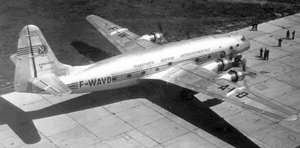Sud-Est Armagnac
|
|
| Sud-Est S.E.2010 Armagnac | ||
|---|---|---|

| ||
| Description | ||
| Role | Long-range airliner | |
| Crew | 4 on flight deck plus cabin attendants | |
| First Flight | April 2, 1949 | |
| Entered Service | April 1952 | |
| Manufacturer | Sud-Est (SNCASE) | |
| Dimensions | ||
| Length | 39.63 m | ft in |
| Wingspan | 48.95 m | |
| Height | 13.50 m | |
| Wing area | 235.60 m² | ft² |
| Weights | ||
| Empty | 37,813 kg | lb |
| Loaded | kg | lb |
| Maximum takeoff | 77,500 kg | lb |
| Capacity | 78-160 passengers plus 48 m³ of freight and luggage | |
| Powerplant | ||
| Engines | Pratt & Whitney R-4360-B13 Wasp Major | |
| Power | 2574 kW (each) | 3,500 hp (each) |
| Performance | ||
| Maximum speed | 525 km/h | mph |
| Operational range | 5,150 km | miles |
| Service ceiling | 6,800 m | ft |
| Rate of climb | ft/min | m/min |
| Avionics | ||
| Avionics | ||
The Sud-Est S.E.2010 Armagnac was a large French airliner of the late 1940s, intended for transatlantic service. After delays to the planning thanks to World War II, work proceeded quickly and the first prototype flew on April 2, 1949. The aircraft was intended for Air France, but the airline refused delivery in 1952 when the first production aircraft was ready. Performance and range were disappointing. The planes - eight instead of a projected fifteen, were picked up by TAI (Transports Aériens Intercontinentaux) (later UTA), who used them for eight months and then discarded them as unprofitable. The aircraft passed to SAGETA (the Société Auxiliaire de Gérance et d'Exploitation de Transport Aériens) who used them in French Indochina for transport duties. They were highly regarded in this role, but French rule in the area was almost over and they were surplus by mid-1954. All were broken up in 1955.
At the time, the Armagnac was one of the largest civil aircraft ever built. It had a wider fuselage than other airliners of the time, a full 4.7 m wide, which gave it a much roomier feel and greater capacity, foreshadowing the future wide-body jet airliners. Up to 160 passengers could be carried, a large number for the time. Unfortunately the aircraft's range proved inadequate for its intended transatlantic use, and for this reason Air France refused the aircraft. It was also somewhat underpowered, but otherwise is reported to have flown well. It was simply too big for the available shorter-range routes, and was therefore unprofitable.
American engines were used, the Pratt & Whitney R-4350-B12 Wasp Major radial, the largest piston engine ever placed into production for aircraft use.
| Related content | |
|---|---|
| Related development | |
| Similar aircraft | Lockheed Constellation - Boeing 377 - Douglas DC-7 |
| Designation series | |
| Related lists | List of airliners |
|
Lists of Aircraft | Aircraft manufacturers | Aircraft engines | Aircraft engine manufacturers Airports | Airlines | Air forces | Aircraft weapons | Missiles | Timeline of aviation |

